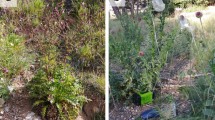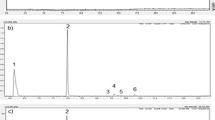Summary.
We report field and laboratory evidence indicating that the defensive compounds secreted by the millipedes Amplinus bitumidus (Diplopoda: Polydesmida) and Anadenobolus putealis (Diplopoda: Spirobolida) attract the carrion scarab Canthon morsei (Scarabaeidae: Scarabaeinae). In a Mexican tropical rain forest, C. morsei was mostly caught in pitfall traps baited with the carcasses of both millipede species. Only a few beetles were attracted to fish carrion. Experimental evidence indicates that C. morsei is attracted to freshly dead millipedes. Benzaldehyde and HCN were identified from Amplinus bitumidus; but 2-methyl-1,4-benzoquinone (toluquinone) and 2-methoxy- 3-methyl-1,4-benzoquinone from Anadenobolus putealis. Benzaldehyde attracted significantly more C. morsei individuals than fish meat, or millipedes of both species did after rinsing in hexane. This is the first report of Polydesmida attracting dung beetles.
Similar content being viewed by others
Author information
Authors and Affiliations
Corresponding author
Rights and permissions
About this article
Cite this article
Bedoussac, L., Favila, M.E. & López, R.M. Defensive volatile secretions of two diplopod species attract the carrion ball roller scarab Canthon morsei (Coleoptera: Scarabaeidae). Chemoecology 17, 163–167 (2007). https://doi.org/10.1007/s00049-007-0375-y
Received:
Accepted:
Published:
Issue Date:
DOI: https://doi.org/10.1007/s00049-007-0375-y




